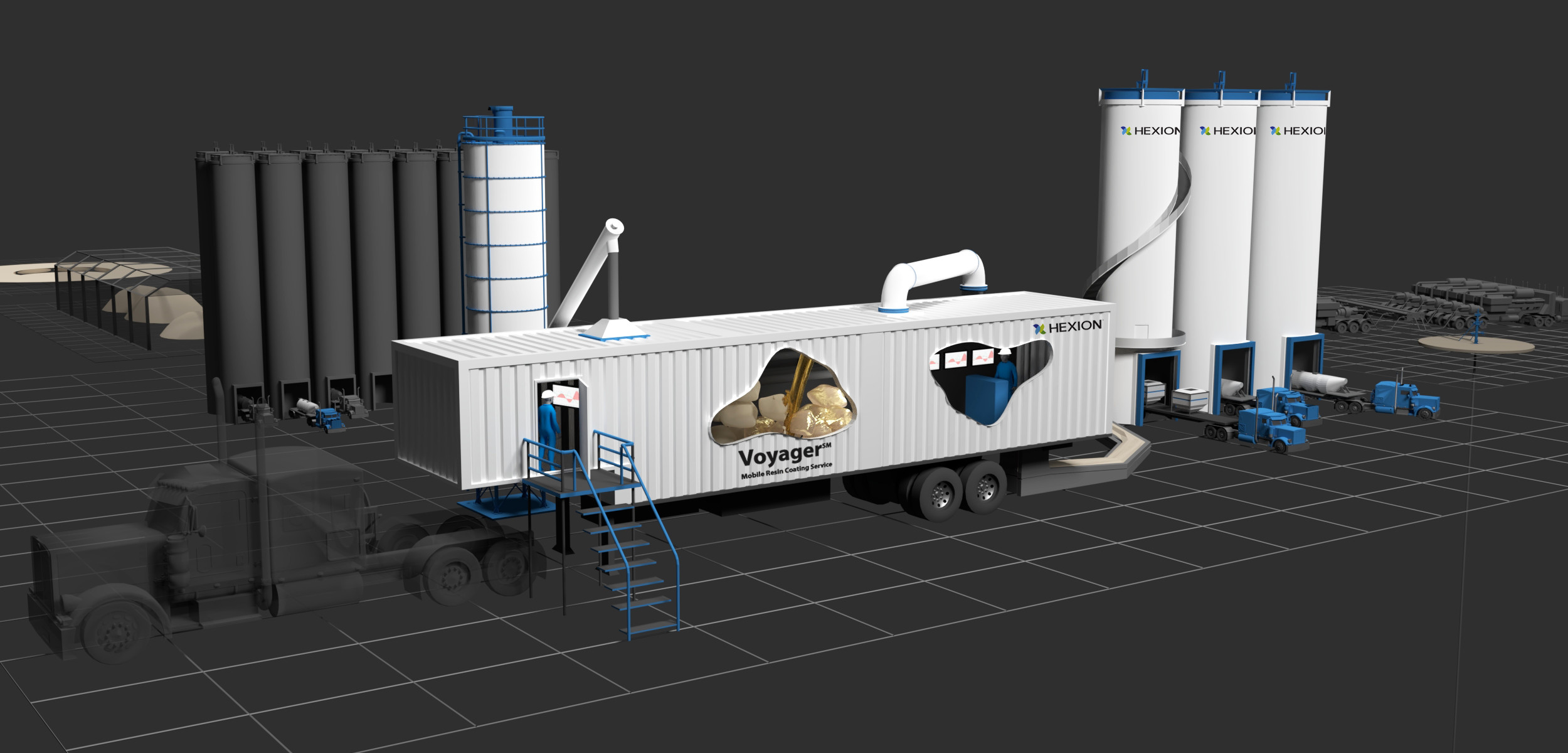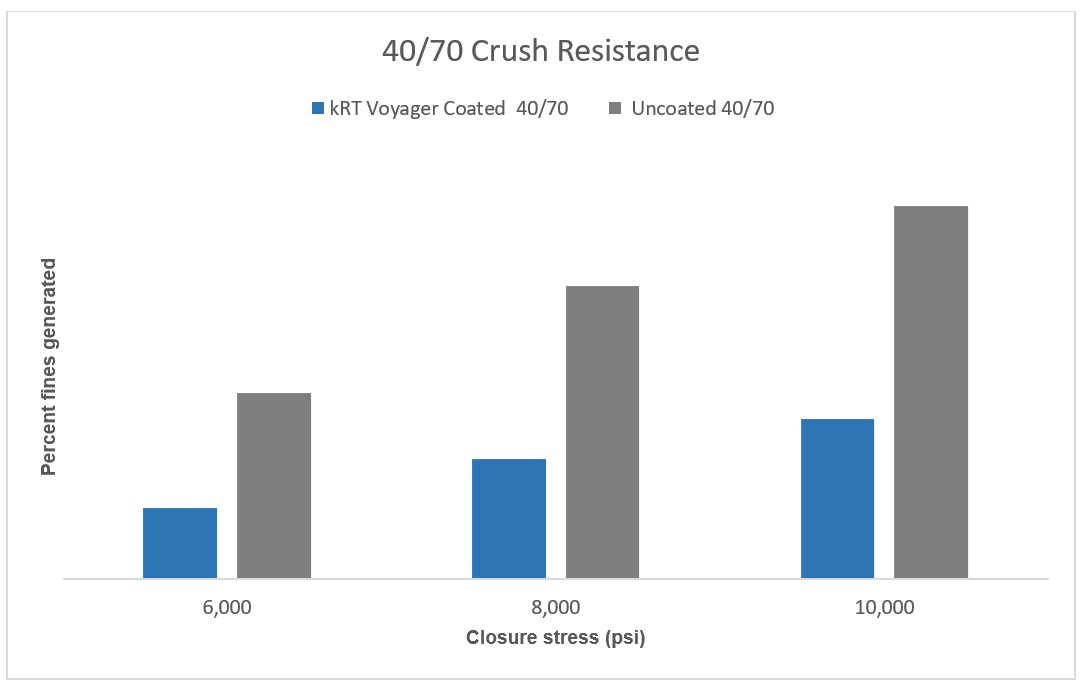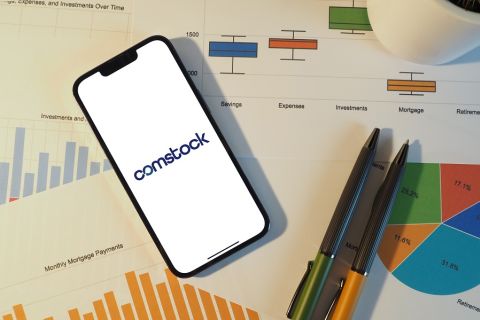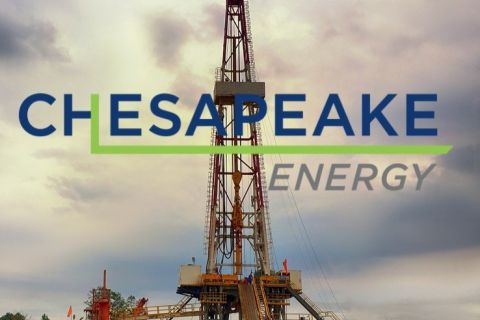The industry adoption of regional sands has led to greater savings and a more efficient service company and operator supply chain. It is estimated that more than 80% of all sand used in Permian Basin hydraulic fracturing operations in 2019 will be locally produced. Permian Basin mines primarily produce smaller mesh-sized sands (40/70 and 100 mesh).
The rapid industry adoption of higher proppant intensities and smaller mesh-sized in-basin sand introduces the challenge of increased proppant flowback. Studies show that smaller proppant particles create a less stable proppant pack and are more susceptible to flowing out of the fracture. There are additional concerns about the ability of regional sand to withstand high closure stress compared to Northern white sand. Proppant crushing negatively impacts conductivity, ultimately leading to underperformance of the well.
Resin-coated sand is an effective proppant flowback mitigator that generates fewer proppant fines at higher closure stresses compared to uncoated sand. Coating regional sands is a viable solution to proppant flowback and crushing issues. However, the majority of traditional coating plants reside out of the basin. Hexion provides a technology that allows the rapid mobilization of coating capability to address in-basin needs.
Mobile resin-coating service
The mobile Voyager resin-coating service developed by Hexion expedites in-basin sand resin coating at a fraction of traditional plant time and cost. The Voyager unit is a fully equipped, resin-coating plant capable of deployment to any domestic or international sand source. Fewer workers are required to operate these units due to their compact size and advanced process
automation. This compaction of the manufacturing process into a smaller footprint contributes to reduced costs compared to a traditional brick-and-mortar coating facility. These units also provide a shorter manufacturing time, providing improved operational efficiency over
traditional plants.
The Voyager resin-coating service utilizes a mobile unit the size of a tractor-trailer (Figure 1). The unit is used in combination with ancillary equipment such as silos, chemical storage and a mobile laboratory. The laboratory contains all the required testing equipment needed to ensure all products meet quality specifications. The total layout is configurable and scalable if additional capacity is required.

Logistics advantage
The traditional logistics model for resin-coated proppants is to transfer uncoated frac sand from a mine to a coating plant by truck or rail. From the manufacturing plant, the coated material is shipped by rail to a transload facility located near the well operations. The coated sand is then loaded and shipped by truck to the well site.
The Voyager unit aims to eliminate additional transportation time and cost by resin-coating sand where the operational cost is the lowest. With a mobile unit deployed at an in-basin mine, transloading costs are avoided by moving resin-coated sand directly from the mine to
fracturing operations. By transporting uncoated in-basin sand and resin-coated sand from the same location, the strain on the supply chain also is reduced.
The Voyager unit can respond rapidly to changing market needs; it can quickly mobilize or demobilize to facilitate relocation as needed to areas of higher activity. This reduces the last-mile cost of transporting resin-coated sand to the well site.
Proppant technologies
The Voyager resin-coating unit currently produces kRT Voyager in-basin resin-coated proppants as well as local sand that incorporates AquaBond Voyager formation water reduction technology. Additional proppant technologies will be available in the future.
kRT Voyager resin-coated proppants are a curable resin-coated sand capable of controlling proppant flowback at bottomhole temperatures as low as 43 C (110 F). Figure 2 shows crush data from an in-basin sand and from kRT Voyager resin-coated proppants that utilized the same sand. The coated sand generates 57% fewer fines than the uncoated sand.

substrate. Note, the crush values may vary depending on the sand source. (Source: Hexion Inc.)
Additionally, kRT Voyager proppants provided enhanced conductivity, cyclic stress resistance and minimized proppant embedment. The coating also reduces respirable silica to levels below the U.S. Occupational Safety and Health Administration action level.
The AquaBond Voyager formation water reduction technology is a specialized coating designed to reduce formation water while improving oil and gas production. The technology alters the relative permeability of the proppant pack to admit hydrocarbons and limit the admission of water. The proppant pack acts as a semi-permeable membrane to selectively allow hydrocarbons to penetrate. A recent case study in the Permian Basin showed that AquaBond technology reduced water cut by 15% compared to offset wells and increased oil production by 28%. Although the main feature of AquaBond technology is water reduction, it consolidates at temperatures as low as 49 C (120 F) to provide proppant flowback control.
Conclusion
Onsite resin coating mitigates many challenges associated with increased in-basin sand usage, such as proppant flowback and reduced sand strength. It also compensates for traditional brick-and-mortar resin-coating operation inefficiencies that result in high costs to the end user. Hexion’s mobile Voyager resin-coating service provides high-performance resin-coated sands and reduces logistics costs. Additionally, the Voyager unit is capable of manufacturing proppant that incorporates AquaBond formation water reduction technology.
The first Voyager unit was successfully deployed in the Permian Basin in the spring of 2018. The latest generation Voyager unit is located at Black Mountain Sand’s El Dorado sand mine in Kermit, Texas. Additional units are scheduled for launch in the near future.
References available. Contact Brian Walzel at bwalzel@hartenergy.com for more information.
______________________________________________________________________________________________
Have a story idea for Shale Solutions? This feature highlights technologies and techniques that are helping shale players overcome their operating challenges. Submit your story ideas to Group Managing Editor Jo Ann Davy at jdavy@hartenergy.com.
Recommended Reading
Some Payne, But Mostly Gain for H&P in Q4 2023
2024-01-31 - Helmerich & Payne’s revenue grew internationally and in North America but declined in the Gulf of Mexico compared to the previous quarter.
Patterson-UTI Braces for Activity ‘Pause’ After E&P Consolidations
2024-02-19 - Patterson-UTI saw net income rebound from 2022 and CEO Andy Hendricks says the company is well positioned following a wave of E&P consolidations that may slow activity.
E&P Earnings Season Proves Up Stronger Efficiencies, Profits
2024-04-04 - The 2024 outlook for E&Ps largely surprises to the upside with conservative budgets and steady volumes.
Jerry Jones Invests Another $100MM in Comstock Resources
2024-03-20 - Dallas Cowboys owner and Comstock Resources majority shareholder Jerry Jones is investing another $100 million in the company.
Chesapeake Slashing Drilling Activity, Output Amid Low NatGas Prices
2024-02-20 - With natural gas markets still oversupplied and commodity prices low, gas producer Chesapeake Energy plans to start cutting rigs and frac crews in March.





